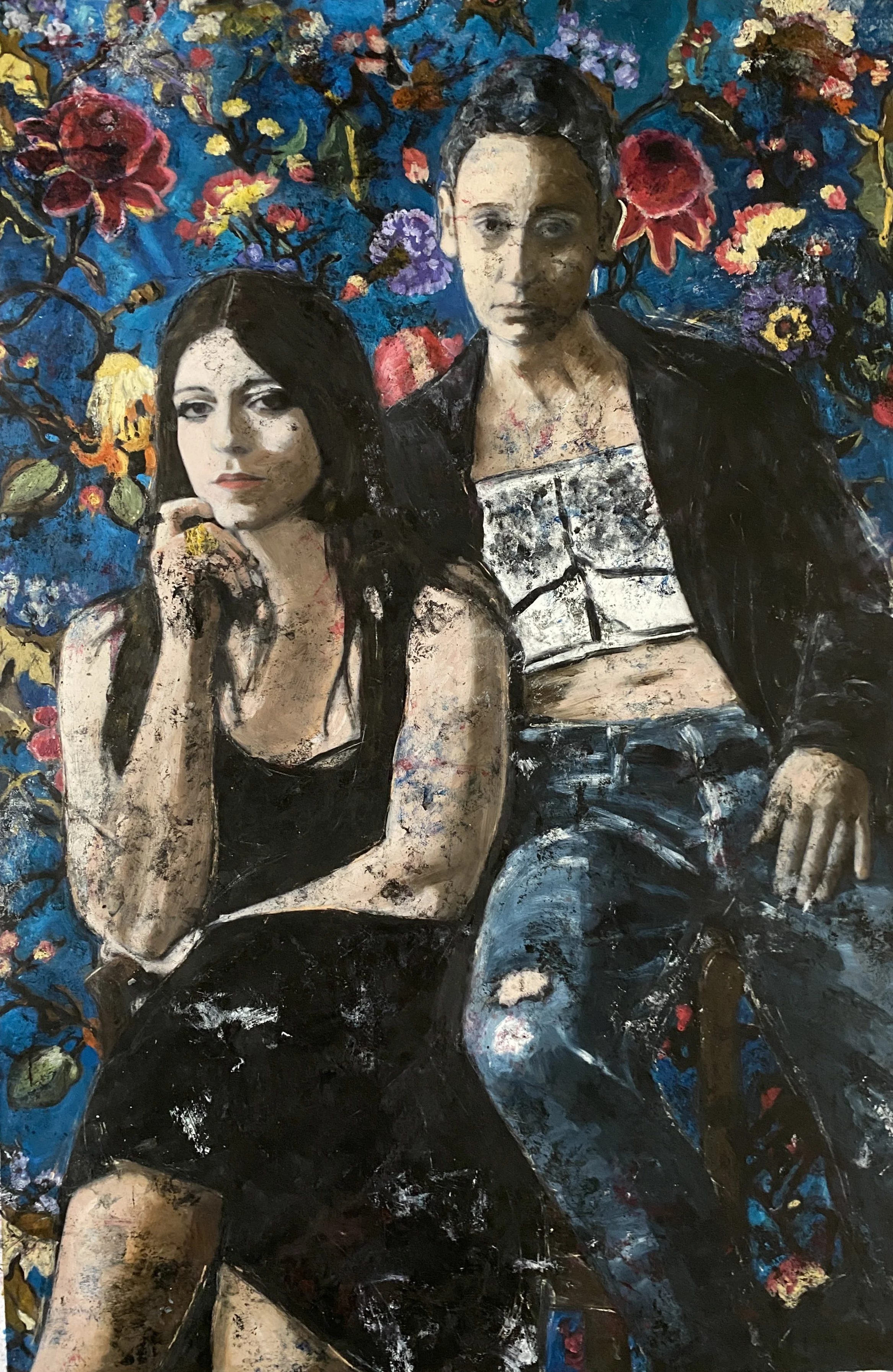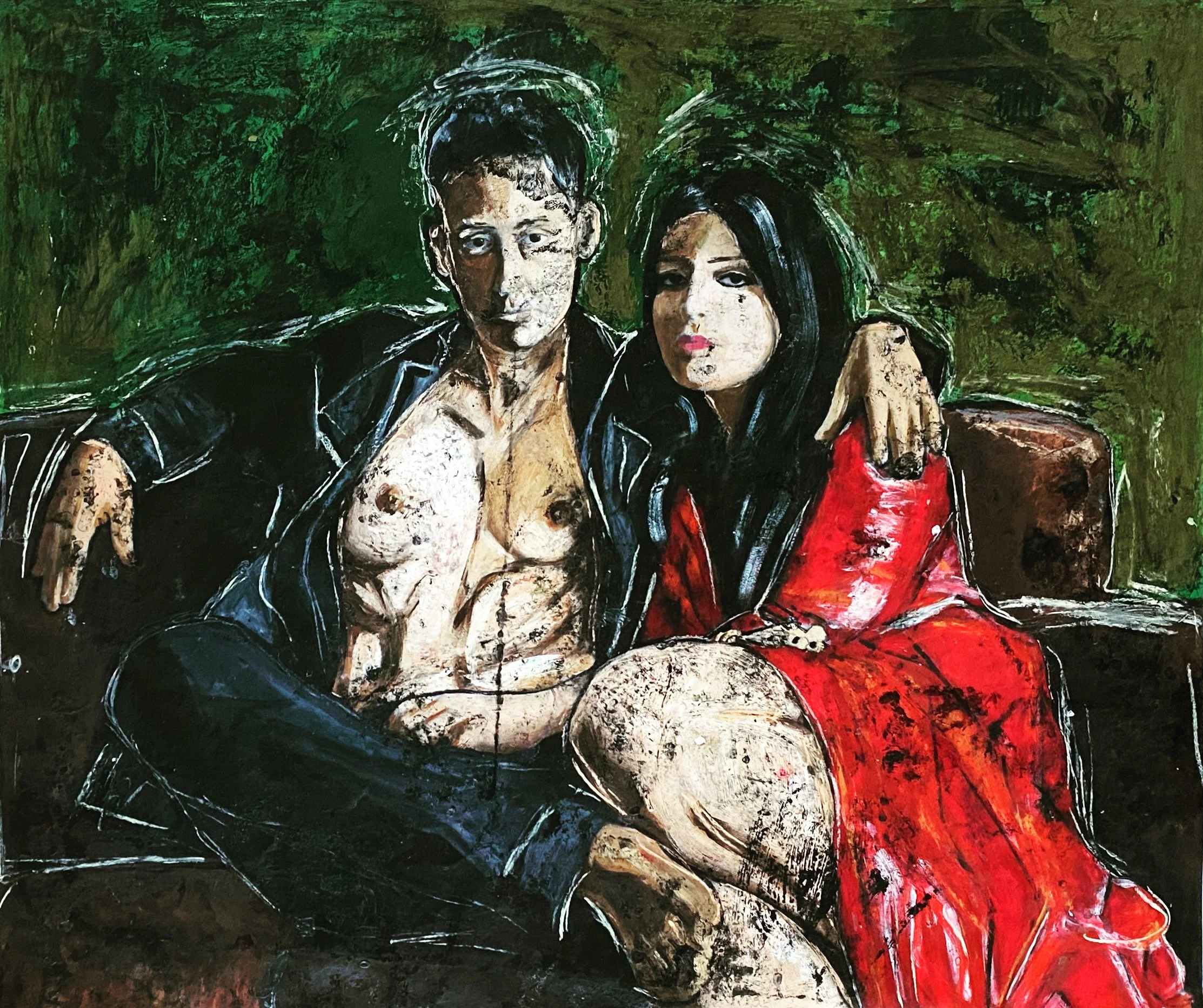Francesca Alaimo: Queerness, Vulnerability and Strength
Earlier this year Guy Cry Club teamed up with the ever inspirational Sassify Zine to help judge an iteration of their Queer Creative Fund. Francesca Alaimo - an Italian British artist currently based in London - was selected as the winner of the fund with their captivating queer narratives carved out from an intricate and transformative process. As well as speaking to Sassify Zine about their work (which you can find here) I spoke to Francesca about the power art can have in expressing identity and in shaping lives.
When did you start exploring your own queerness?
I realised that I wasn’t straight in my mid teens, but growing up in Italy in the 90’s meant that it felt very scary to openly talk about being a lesbian. Society was infused with religion and toxic masculinity, gays and lesbians were not represented on any platform and the idea of non-binary was unthinkable. The few times a gay character appeared on TV it was inevitably a stereotypical effeminate man who was meant to make people laugh. In the imagery of the media lesbians were ugly feminists who hated men and in general they were non-existent, except in the porn industry where they fitted a rather opposite stereotype.
I remember it felt almost impossible to enunciate the word “lesbian” out loud, even though in my mind it made perfect sense. In order to avoid homophobic comments I called myself bisexual and kept long hair to fit in and become invisible.
It was when I moved to London in 2000 that I really started to acknowledge how uneasy I felt in that label. I wasn’t bisexual but I wasn’t just lesbian either. At that time I had a partner who introduced me to the concepts of trans, non-binary and two spirited people, which immediately felt familiar. I realised that I was unknowingly living in a gender dysphoria since I was a child. I was in my late 30s’ when I discovered that there was much more about me than just wearing masculine clothes and a short haircut. It was the way I felt. I knew that I was someone whose image didn’t reflect truthfully in the mirror, and yet that was the real me. I started to explore sexuality in a way that felt empowering to my truest self, yet it brought with it shame and a sense of wrongdoing. It took years to find an equilibrium, a fluidity that most embodies my queerness.
Could you explain what a two spirit person is and the journey you have taken to align with this as an identity?
Two-spirit is a term borrowed from North American indigenous people who have a deeper and more inclusive understanding of gender identities other than male or female.
I like this term because to me it speaks for those individuals who don’t feel represented by our binary male-female system. It tells of possibilities beyond that, which are seen and respected as real and true.
Having been raised in an environment where being male or female were the only possible options, it was only after I left Italy, spent some time in South America with a community of lgbtq artists and finally moved to London that I began to explore my identity from the non-binary perspective. I realised that the way I felt about my own gender was more transmaculine or masculine of centre while also very politically female, all at the same time. It’s a fluidity that still moves on a spectrum and there will always be days when my feelings will just not translate, partly because of the exposure to societal heteronormativity since childhood, partly because language simply can’t define/describe us in our entirety. But I’m ok with that, as art will always allow me to explore and express feelings and emotions on a deeper, more abstract way. It’s a very exciting path.
How has art helped you to understand your own identity?
I have been exposed to art in all its forms since I was a child. My father used to paint in his spare time and my mother was a socialist, a feminist and an enthusiast of anything creative. We would visit exhibitions, attend concerts, watch films and sometimes go to the theatre, which is amazing as my parents were working class and had very little money. There were, however, lots of opportunities to immerse oneself in the arts for free.
In summer we ventured into very long journeys by car around Italy or Europe, which meant I got used to seeing and interacting with many different cultures. Growing up I discovered a tiny cinema hidden away in a basement, run by an Argentinean gay man, that had an all lgbtq programme and I became a regular visitor. It really was an eye-opener for me and generated a whole lot of new thoughts and questions about myself.
I think that this openness to the ‘otherness’ and ‘new possibilities through creating’ as well as the sense of freedom that such a lifestyle would inspire, meant that I was always searching for answers outside the box. Theatre in particular was how I escaped reality and imagined to be who I longed to be. It’s no surprise that some of my paintings have a strong theatrical influence.
Despite growing up in a country where lgbtq people were invisible I was lucky to receive an artistic upbringing that partially counteracted societal constraints and protected me in the long term. I am very grateful to my parents for that.
Most of us are brought up in a binary heterosexual/normative society. How did art help you challenge these ideas?
Art has penetrated all aspects of my life since an early stage, so much so that my natural response to trauma or deeper questioning has always been to start painting, taking photographs or making videos that would challenge the idea of ‘normality’. The simple act of making art has allowed me to visually and emotionally explore myself and to express how I truly feel about my identity. During my years at University I worked on a photographic project on Caravaggio called Digressions of Self. I re-enacted some of his paintings but substituted the male protagonists with myself. It was my fist attempt to start a discourse on gender non-conformity and offer the viewer a shifted perspective and a place of questioning. In the years that followed I continued to explore my own image using photography to portray what I saw in the mirror, which was a very androgynous me, not quite female or quite male. I explored my body interacting with female bodies, once again creating an illusion that transformed my real physical self into my true physical self. These are examples of the path I have intuitively followed in my explorations of Self and my artistic growth, which have helped me challenge and overcome the curb of binary heteronormativity I was born within. In the last three years I’ve been focusing on paintings and interventions that represent directly and unapologetically me.
How do you discover and connect with artists and work that inspires you?
I connect with artists mostly on Instagram. When their work inspires me I try and go to their PV [private view] and say hi. I also attend music/art/performance events whenever I can. It is really amazing how many incredible people I have met this way. Other artists live outside the UK but we still connect online.
I listen to art podcasts, such as The Great Women Artist with Katy Hessel and Talk Art with Russell Tovey and Robert Diament, which discuss both past and present artists. Last but not least I visit galleries and museums in London and abroad when I’m travelling.
How do you approach a piece of art? What’s the process?
Images and ideas form in my mind and I start with taking photographs. Selecting the one I want to paint is based on a visceral decision. I choose the one that feels right. Interestingly I often realise why only after I finish the piece.
I paint the printed image with oils and acrylics and then I proceed to “undo” the painting using melted wax. I do this because it challenges the idea of perfection, of the flawless finished work of art. Art, like life, isn’t perfect. Humans aren’t perfect or balanced. In fact, we are raw and destructive, beautiful, tender and cruel and violent at the same time. Art as a “thing of beauty” doesn’t make any sense anymore, not to me anyway. In any case, we would have to embark in a debate on what defines beauty in the first place. My process also involves transformation, which is relevant to its subjects and representative of who I am. Each piece is an intervention on and intervention with and the artwork becomes the object and the maker of itself. In fact, I never quite know how it will turn out until it’s done. The wax, the colours and the paper interact with each other semi-independently from my initial vision. This makes my process super exciting and unnerving at the same time!
What do you hope others see in your work?
I have always believed that art is a form of communication that happens through infinite channels. I want to tell people stories, tell them about a journey, a transformation, a discovery, a realisation, a memory, a nostalgia, an epiphany. My art is my telling and each piece is a story, but I don’t expect people to read my work the way I tell it. Often a new story is created, unique to the interaction between the viewer and the artwork. However, even if each story is different, sometimes a deep connection occurs and someone tells me that they identify with my piece, that my work speaks to them, that they felt seen. That’s truly all I hope for.
Do you think there’s enough representation and opportunity for gender non confirming, non-binary people in art?
I feel that, in recent years, there has been an increased interest from independent galleries in showing gender non-confirming artists. This might be due to new virtual exhibitions tools and social media platforms, which bring visibility to all artists around the world. However, more conventional galleries and museums are still very cautious when it comes to lgbtq art. There seems to be an “acceptable” visual approach to themes of gender identity and sexual orientation and anything that doesn’t fit that code doesn’t get selected, which is a form of censorship of course. I feel that the discourse on gender non-conforming has just begun, with many people still struggling to understand this concept, let alone accepting it. For exactly this reason there should be more conventional platforms open to non-binary artists, which would enable them to reach a wider audience that’s open to learning.




